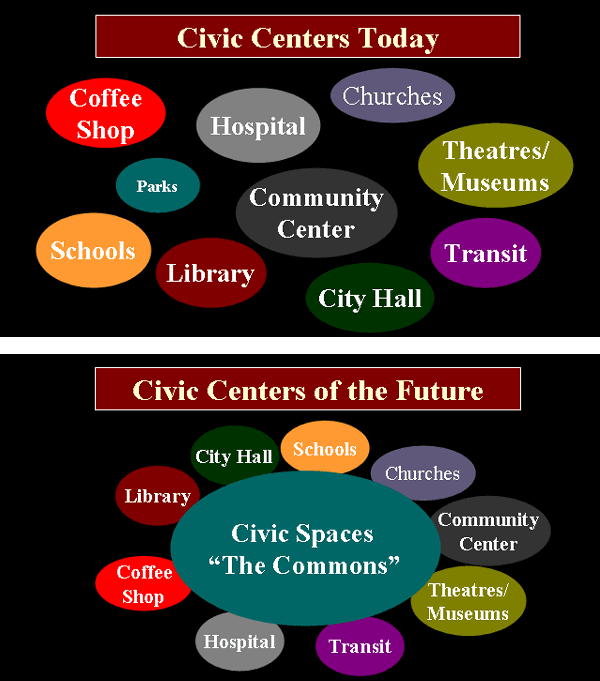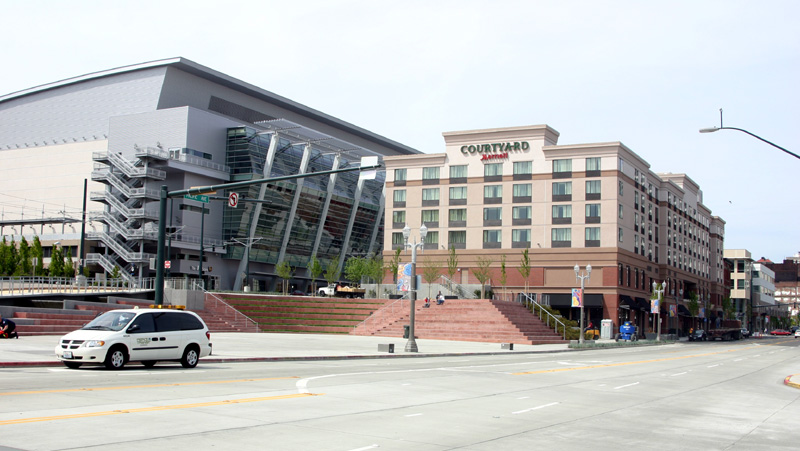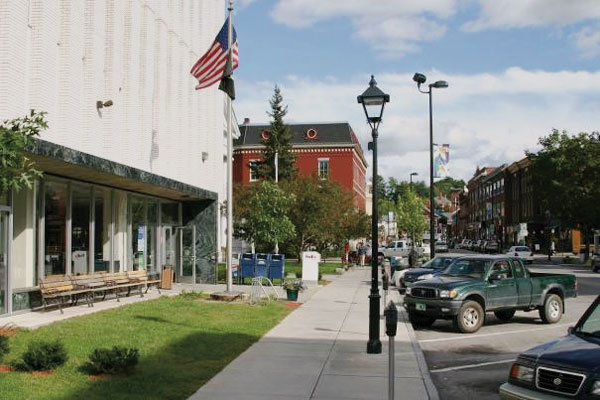A biweekly newsletter with public space news, resources, and opportunities.
A curated dispatch on all things public markets plus the latest announcements from the Market Cities Program.
By Cynthia Nikitin
Traditionally, the center of most cities has been a "commons," a civic space built according to democratic principles. The commons may be a historic commercial square, as in Madison, Wisconsin, or it may be a mall (in the original sense), like the ones that grace San Francisco's City Hall and the US Capitol. In almost every case, major public and cultural institutions are located around the commons, forming a civic center of enormous practical and symbolic importance.
Libraries are the cornerstones of many civic centers. They may be joined by city halls, museums, government offices, churches, opera houses, courthouses, or any number of other public-minded institutions. With strong partnerships and a clear purpose, the people behind these buildings can breathe life into their shared public space--the commons--and create a vibrant, cohesive district. A fully-realized civic center proclaims the mission and identity of its institutions for all to see, so that the commons becomes a forum for public expression and a source of community pride.

Pitfalls abound on the path to success, however. One of the biggest problems is that civic centers are not always seen as cohesive districts, and often fail to function as engaging public spaces. There are few things more dispiriting than an empty courthouse square or grand library steps without a soul in sight. The failure of such places raise disturbing questions about the fate of the public realm itself.
Lively civic centers showcase the strength of their community and help kindle a democratic spirit. To help create better civic spaces around the country, PPS looks at the major stumbling blocks we have observed in our work with libraries, museums, courthouses, and other public institutions--and outlines proven strategies to overcome these problems and establish a vital commons at the heart of our cities.
Downtown Tacoma, Washington boasts a resurgent historic core with plenty of potential for a first-class civic center to emerge. That's what city leaders had in mind when they built a new public square called Tollefson Plaza in the center of downtown, less than a block away from three museums, a convention center, a branch of the University of Washington campus, and a historic train station adapted for re-use as a Federal Courthouse. But residents soon discovered that the plaza's fantastic location provided no guarantee that it would automatically "work" from the moment it opened.

Lacking a clear mission or program, the plaza debuted with many important questions still unanswered. Who would use it? What would people do there? Who would manage it? The cornerstone institutions that surrounded the plaza had no mandate to program it. Nor were they sure how their own patrons might use it, what activities people could do there, or how they might help run the plaza over the long term. On top of that uncertainty, cost concerns prevented amenities like restrooms, concessions, and seating from seeing the light of day. When the plaza opened, few people used it besides skateboarders and the homeless.
All over the world, there is a pattern of situating civic institutions next to each other. Though they may share the same streets, the same audience, and even many of the same goals, they hardly ever communicate with each other. As a result, many opportunities to achieve mutual objectives go unfulfilled. For instance, when the Inter-American Development Bank in Washington, DC found itself in desperate need of a child care center, they struggled mightily to re-design their ground floor to accommodate it. Little did they know that directly across the street, a Presbyterian Church was planning to close its child care facility due to lack of enrollment. Without active relationships between institutions, mutual opportunities go unfulfilled and the district as a whole suffers.
Many civic center districts have multiple improvement efforts--led by different agencies--underway concurrently. A lack of coordination often results in overlap, inconsistencies, or gaps in implementation. For instance, sidewalk improvement projects conducted by two agencies may use completely different materials, or a street may get dug up five separate times (for new sewer lines, fiber-optic wiring, etc.) instead of handling everything in a coordinated manner. The missing link is communication. A great civic center is more than just a group of buildings--it also needs a robust network of partnerships to fully succeed.

Surprisingly, the layout and atmosphere of many civic centers discourage people from getting around on foot. Even though offices, restaurants, shops, and cultural institutions may be located close together, a poor pedestrian environment makes them feel cut off from one another. In many cases, streets are simply designed to accommodate more and faster traffic than what's needed, which negatively affects perceptions of pedestrian safety.
Republic Square in downtown Austin, Texas, for example, feels like an island unto itself, surrounded by fast-moving traffic on three sides. As a result, tenants and visitors who frequent the neighboring art museum, state office building, and warehouse district rarely take advantage of this welcoming green space. The space is currently being redeveloped as Republic Square Park, which will be the front yard for a new federal courthouse and a revitalized post office complex. Managing traffic in this four-block area--and getting more feet on the street--is imperative for the park to emerge as the heart of a thriving civic center.

A great civic center needs a name that will stick, or else most people won't even know it's there. It sounds simple enough, but a surprising number of civic centers have yet to stake a claim to their own identity. They need to be named, marketed, and branded in a way that no one will easily forget.
Until a few years ago, the federal properties in Denver, Colorado suffered from an identity crisis. They were perceived simply as a collection of government buildings, residential developments, and offices without a cohesive character. When plans got underway for a new light rail stop in front of the district's historic federal courthouse building, the Regional Transportation District jumped at the chance to remedy the situation. Working in partnership with the courts, the city and the General Services Administration (which operates the courthouse), the RTD named the area the Denver Federal District. While far from poetic, this name helped transform public perception. Today the Federal District is thriving thanks to management that programs its spaces and plans for improvements.
Cynthia Nikitin is Vice President for Civic Centers and Downtowns. Contact her at cnikitin@pps.org.
The rich text element allows you to create and format headings, paragraphs, blockquotes, images, and video all in one place instead of having to add and format them individually. Just double-click and easily create content.
The rich text element allows you to create and format headings, paragraphs, blockquotes, images, and video all in one place instead of having to add and format them individually. Just double-click and easily create content.
Body Text Body Link
The rich text element allows you to create and format headings, paragraphs, blockquotes, images, and video all in one place instead of having to add and format them individually. Just double-click and easily create content.
Here is some highlighted text from the article.




Headings, paragraphs, blockquotes, figures, images, and figure captions can all be styled after a class is added to the rich text element using the "When inside of" nested selector system.
Headings, paragraphs, blockquotes, figures, images, and figure captions can all be styled after a class is added to the rich text element using the "When inside of" nested selector system.
Headings, paragraphs, blockquotes, figures, images, and figure captions can all be styled after a class is added to the rich text element using the "When inside of" nested selector system.

We are committed to access to quality content that advances the placemaking cause—and your support makes that possible. If this article informed, inspired, or helped you, please consider making a quick donation. Every contribution helps!
Project for Public Spaces is a 501(c)(3) tax-exempt organization and your donation is tax-deductible within the guidelines of U.S. law.